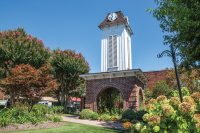Cherokee passport checkpoint a fun reminder
Martie Hoofer was driving her motorcycle into Cherokee from the Great Smoky Mountains National Park when an Anikituhwa warrior dressed for battle stopped her and asked for her passport.
“I was shocked,” Hoofer said. “I believed him. My passport is at home.”
Sonny Ledford, a founding member of the Warriors of Anikituhwa, stopped Hoofer and her son Sam and addressed them in Cherokee, his war club clasped in his right hand.
Ledford was participating in a new effort to market the Cherokee Passport, a tourism booklet produced by the Goss Agency that highlights the many cultural activities available in Cherokee.
“It feels like when they used to do it in the earlier times,” Ledford said. “In a way it’s telling people you’re coming onto our land to hear about our people, and we are going to give you a passport so you are welcome.”
The Anikituhwa Warriors are a group of men who speak Cherokee and dress in 17th century traditional costumes. Ledford’s traditional name through his paternal bloodline is Usquetsiwo, which means “wears something on his head,” a reference to the Cherokee warriors’ headdress.
Related Items
“There’s too much stereotypical Indian out there and people believe it’s true,” Ledford said. “This is who we are.”
The passport checkpoint was essentially a public relations stunt, but it was a significant way of reframing Cherokee as a tourist destination.
The passports have event schedules, write-ups of rich cultural offerings and a short list of free things to do, but their focus is on Cherokee as a cultural landmark.
Robert Jumper, travel and tourism manager for the Eastern Band of Cherokee Indians, helped organize the event.
“It’s a fun reminder of the culture of the Cherokee,” Jumper said. “Certainly you can see the sovereignty of the nation in this, but it’s really just a fun way to introduce visitors to Cherokee.”
Mike Crowe, another of the warriors, said dressing up in traditional attire was an honor.
“We don’t speak in terms of pride. We speak in terms of honor. Adelagwodi. It’s like honor a thousand times,” Crowe said.
Crowe was wearing wampum prepared by Robert Saunooke and a war club fashioned by Ledford.
He said he hoped the checkpoint would encourage tourists to dig deeper into Cherokee culture during their visits.
“Hopefully they’ll get it through their head to check out our museum, our village, and come away with a better understanding of who we are as a people,” Crowe said.
If Karen Bess of Fishersville, Va., is representative of the other tourists that passed through the checkpoint, the plan worked.
“I liked it,” said Bess. “I’ve always been fascinated by Native American culture.”









